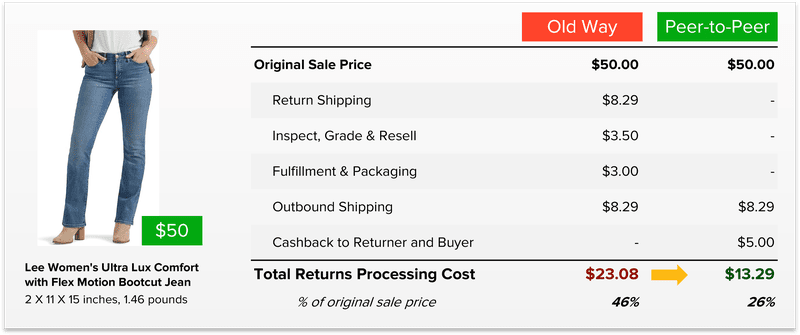Top 8 Marketing Strategies For Making Free Shipping Profitable

Last updated on March 13, 2025
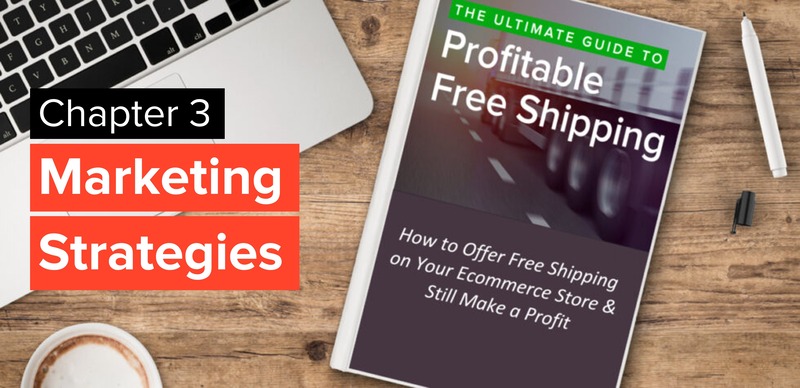
In this article
 21 minutes
21 minutes
- Intelligently Set Minimum Order Value
- Offer Free Shipping with Loyalty Programs
- Offer Free Shipping for a Limited Time Window or Amount
- Offer Free Shipping at Peak Seasons of the Year
- Offer Free Shipping on Returns Only
- Offer Free Shipping to First-Time Customers Only
- Offer Date-Certain Shipping
- Consolidate and Deliver Multiple Orders on Fixed Dates
- Summary
- Frequently Asked Questions
Free shipping isn’t just a perk, it’s a powerful marketing tool that influences buying decisions and customer loyalty. It’s a deciding factor in where and how people shop. Shoppers are bombarded with choices, and offering free shipping can be the difference between an abandoned cart and a completed sale. However, without a strategic approach, it can also become a financial burden that eats into profits. The key lies in leveraging free shipping as part of a well-planned marketing strategy; one that drives conversions, increases average order value, and strengthens customer retention. In this article, we’ll explore 8 innovative ways to make free shipping work for your business without sacrificing your bottom line.
1. Intelligently Set Minimum Order Value
It would be best to avoid delivering low-cost items for free as their shipping costs are often higher than the cost of the item itself, leaving only so much margin. Setting a minimum order value in your shopping cart helps you generate enough margin to recover some of the shipping cost. One study has revealed that about half of the shoppers will add additional items to their shopping cart just to qualify for free shipping, making a great case for setting a minimum order value for free delivery.
However, be mindful that there’s a fine line between setting a minimum order value that will increase total sales and one that will drive away the customers. There are different ways to test what that right amount is. Don’t set a limit too far away from your average order value. It should be just enough for customers to add a couple more items at most.
The following is a simple model developed by a data analytics company, RJ metrics:
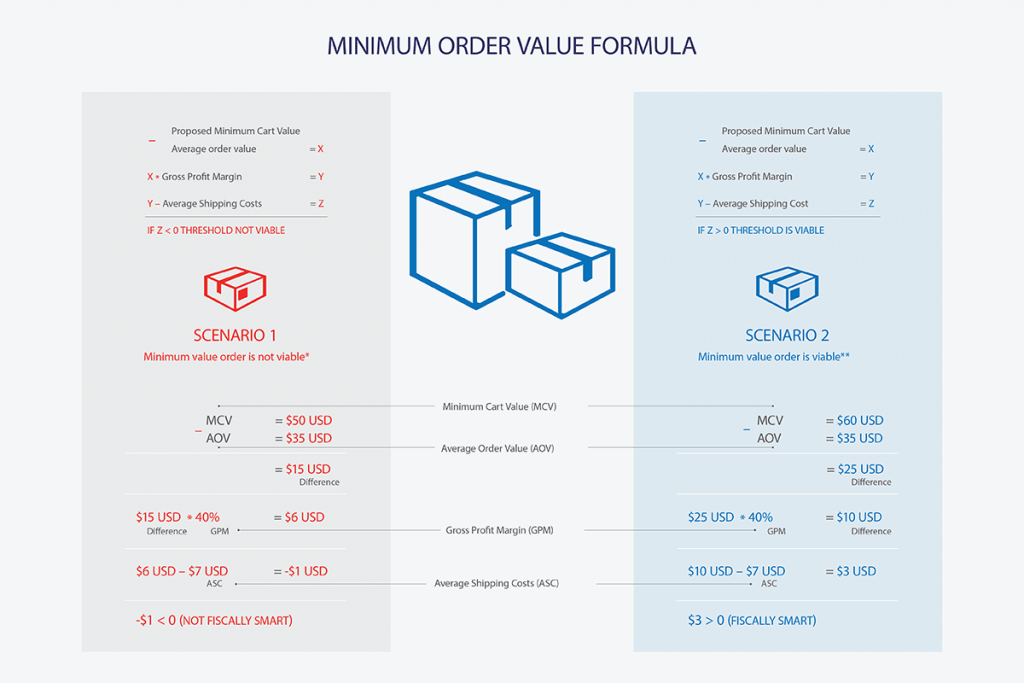
To learn more about calculating your minimum order value, check out this guide by DSers.
2. Offer Free Shipping with Loyalty Programs
Loyalty programs are customer memberships offered by retailers in exchange for various perks, including free shipping. The customer is charged a fee or must collect points against regular orders to enjoy the perks of the membership. It is designed to encourage repeat purchases, enabling retailers to absorb the shipping costs.
Some big retailers offer the membership to customers for free; solely in exchange for basic personal details such as email account, name, address, gender, and birthday. Retailers use this information to encourage more purchases through targeted marketing efforts. They leverage customers’ purchase history and demographics to send special offers and personalized catalogs.
The increase of purchase frequency from a loyalty program is reflected in the customer lifetime value (CLV), which is the basis for most loyalty programs. CLV refers to the dollar amount that a customer is worth to you between their first and last purchase from your business. It is easy to calculate with a formula:
CLV = ((Average Order Value) x (Average Gross Margin) x (Average Number of Transactions per customer over a year) x (Average Lifespan of a Customer in years)) + ((Loyalty Program Fee per year) x (Average Lifespan of a Customer in years))
For a loyalty program to be successful, CLV should increase when compared to CLV without the loyalty program. Let’s walk through an example. Before loyalty programs, if your Average Order Value was $50, Average Gross Margin was 20%, the Average Number of Transactions per customer over a year was 8, and customers only stayed for 1 year (Customer Lifespan), then:
CLV: ($50 x 20% x 8 x 1) + $0 = $80
Now suppose you offer free shipping for a yearly fee of $50, you’ll see a few changes in your metrics. Your Gross Margin goes down to 10% because of $5 assumed average shipping expense per order, but the customers are likely to stay with you for twice as long (that is two years). In this case:
CLV: (($50 x 10% x 8 x 2) + ($50 x 2)) = $180
Since there is an increase in CLV despite a decrease in Gross Margin, the loyalty program worked in this case. And this estimate has not accounted for increased purchase frequency from customers wanting to take advantage of the free shipping.
Even if you don’t charge a monthly fee, the point system is a good alternative. The points-based system encourages customers to keep shopping and take advantage of free shipping. Also, it can be designed to ensure there is enough additional margin to make up for shipping costs. Another driver of sales are tailored offers and product catalogs.
In some cases, loyalty programs such as supermarket cards end up being a discount program without getting any more loyalty from the customer. Customers get membership cards from all supermarkets they visit and either shop all the discounts across all supermarkets or shop for the one with the most discounts on a given shopping trip. So it’s not really a loyalty program as much as it is data collection that helps the store offer even more discounts by way of additional tailored coupons. Therefore, it is necessary to design loyalty programs to increase your profitability and reward increased spending.
A few good examples of membership programs designed around free shipping would be Instacart, Shipt, and Walmart. Instacart and Shipt’s annual memberships provide free grocery deliveries for orders over $10 and $35, respectively, at $99 per year, which basically encourages a monthly shopping behavior from its members (other service fees apply). Walmart+ is Walmart’s subscription-based loyalty program with a price tag of $12.95 per month or $98 per year, with no order minimum.
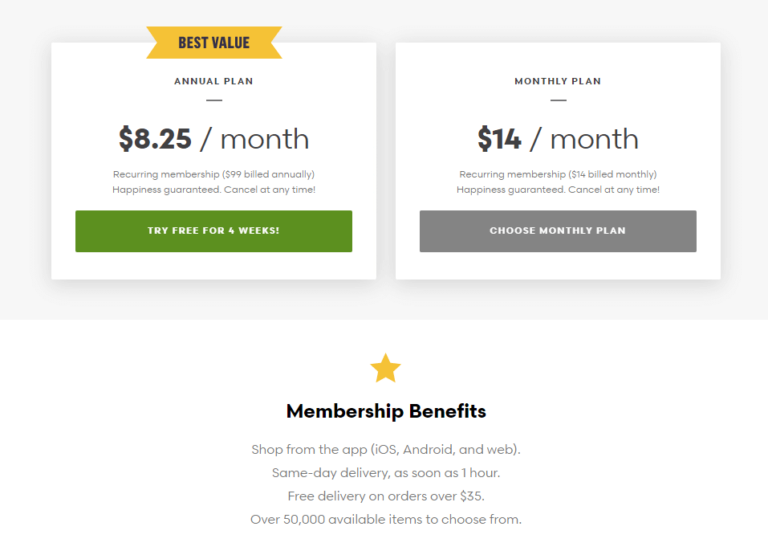
A few retailers that do unpaid loyalty well are Sephora, ShopRunner, and Starbucks. If you look at the Free Sephora Beauty Insider program, it rewards dedicated beauty shoppers with more than discounts and free shipping; it offers a free birthday gift, exclusive events, and other extra frills. Customers are encouraged to buy more and stay on to reap the benefits tailored right for them.
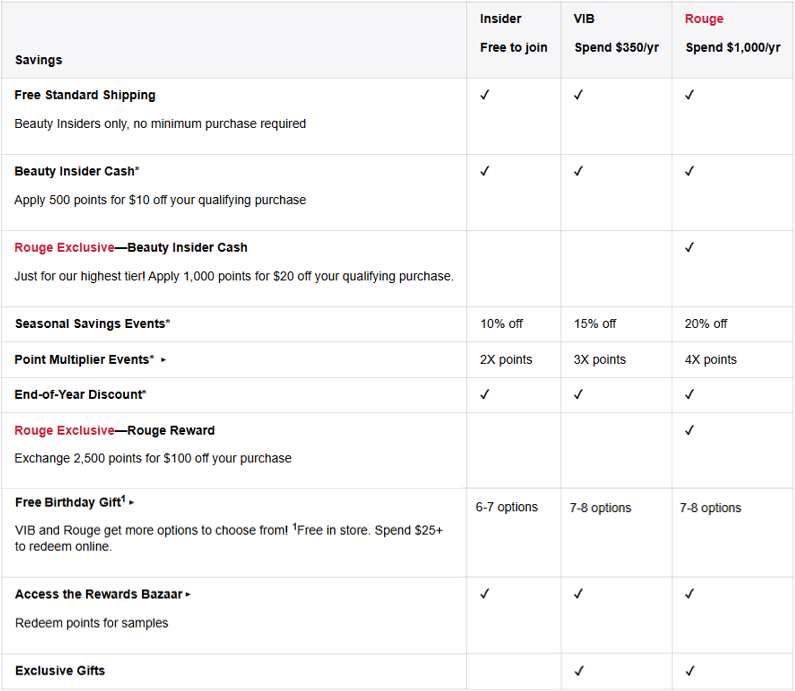
Another unique membership program is Shoprunner, which partners with high-end luxury retailers to provide free 2-day shipping and free returns for its members. The membership is currently free for customers, potentially charging the retailers for the express delivery service.
The well-known Starbucks Rewards program is points-based and rewards customers with stars based on the number and value of their purchases that can be redeemed for free drinks and food. Going beyond basic points, it comes with a free birthday item, access to exclusive games and games, free refills on certain drinks, skip-the-line with Order Ahead, and more.
3. Offer Free Shipping for a Limited Time Window or Amount
If you’re not yet set to offer free shipping all the time, free shipping for a limited time serves as a great marketing tool in many cases. The purpose of providing free shipping here is to encourage additional purchases and build a relationship with the customer for future business.
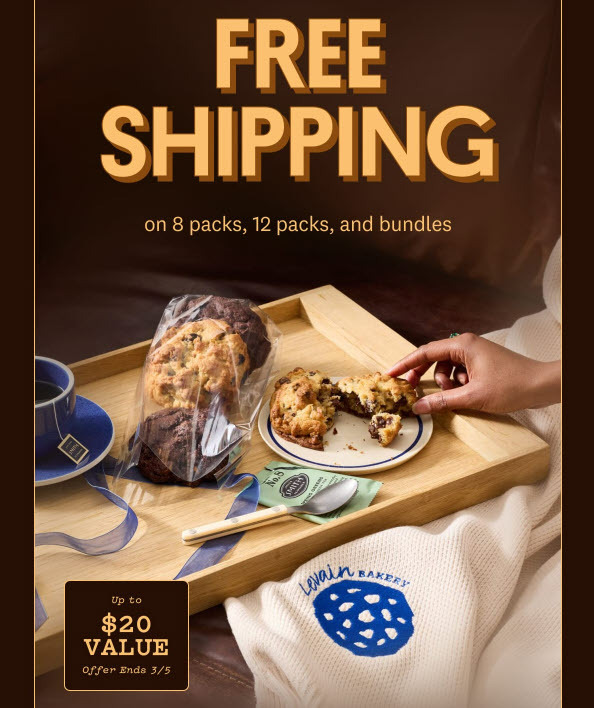
Very simply, you need to set a target of future incremental sales from customers who have used the free shipping promotion. The margins from incremental sales should cover the costs of shipping during the offer and help you assess the success of your campaign. Additionally, just acquiring more customers could increase brand awareness, which will attract new prospects organically in the future.
One way to make this limited-time offer work without sacrificing too much profitability is to adopt value limits. Like in the cookie example above from Levain bakery, the free shipping discount is limited to $20 because the cookies need to ship using 2nd Day Air services, which can quickly get very expensive. The amount is enough to provide free shipping to neighboring states but will not be enough to cover cross-country shipments.
If you have a high engagement rate on your web store but a low conversion rate, that means customers need a nudge to complete the checkout. Offering a limited-time free shipping offer will excite prospective buyers and turn window shoppers into paying customers. Temporary free shipping can be an excellent investment to boost sales during slow periods. It is essential to be careful about frequency to not habituate the customers to free shipping.
You can be creative by offering a limited time offer through different shipping strategies:
- Offer free shipping on next purchase to customers only after checking out. This acts as a reward for shopping with you and encourages the customer to explore your catalog for future purchases.
- Offer customers free shipping when they share their purchases on social media or after writing a product review. Here, you are using free shipping to increase your exposure and potential sales via consumer generated content.
- Send a free or discounted shipping promo code by email or text if a cart has been abandoned.
The broad idea is to invest in the shipping cost for a few orders to acquire more customers and get more future orders.
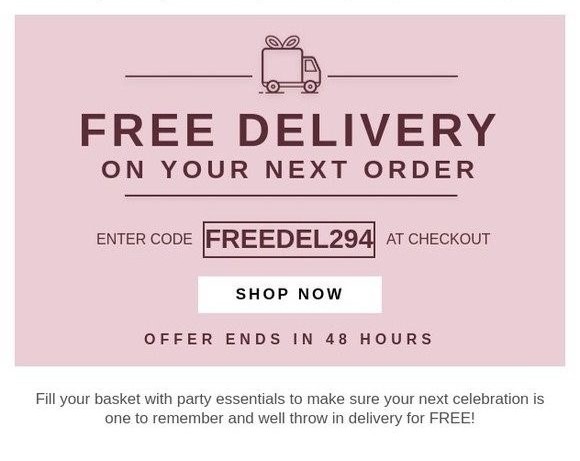
4. Offer Free Shipping at Peak Seasons of the Year
Free shipping is not a value creation strategy if you do not have enough sales to increase your bottom line with reduced unit margins. Therefore, offering free shipping during peak season could be a better idea. One, there is potential for more sales, and two, you need to be competitive when everyone is offering some kind of promotion. Free shipping is “a cherry on top” of any other promotion.
Every business has a seasonality to it. Depending on your products, test out free shipping offers during different times of the year such as Christmas, Mother’s Day, Valentine’s Day, Amazon Prime Day and Back-to-School.
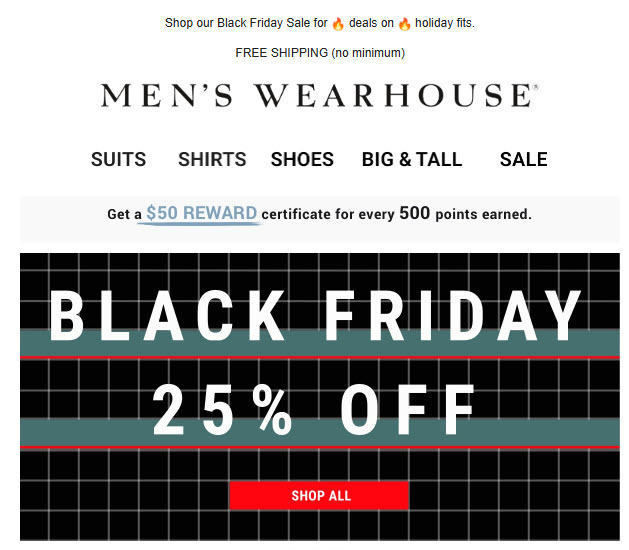
Third-party Sellers on various marketplaces such as Amazon could also benefit from offering free shipping during their flagship sale day. Increased customer traffic on Amazon during Prime Day can work in your favor only if you can stand out. Even if you don’t offer free shipping all year round, temporarily offering free shipping could help you convert a larger share of the increased traffic to the site.
Best Buy has been offering free shipping to all customers during its peak holiday sales season. Target, on the other hand, offered free expedited shipping before Christmas on most of its items. The key was to increase sales during the peak season and get an even bigger share of the pie than usual.
The objective of this shipping strategy is to increase profits by increasing gross sales at a lower margin but be mindful of not losing money on every sale. Customer acquisition can be a secondary goal, but the primary purpose of this shopping lift should be to increase your overall profit. It’s possible that customer spending on your site during the off-peak season might not cover the promotional free shipping losses incurred during the peak season, so you may have to wait until the following year for a possible pay-off. Therefore, be selective about what products you offer with free shipping.
5. Offer Free Shipping on Returns Only
The prominence of online shopping has made returning products much more important in recent years. Customers care about the ability to return the item if they are not satisfied with it almost as much as free shipping. Therefore, there is an opportunity to attract customers by offering free shipping on returns as a feature of shopping with you.
There are a few categories where the customer thinks about returns even before they have made the purchase. These are the products that conventionally require a trial. Anything in the fashion category, house décor, and jewelry fit are example categories.
When customers shop for clothes, they cannot be 100% certain of the fit or how they would look wearing the product. The risk of losing the conversion is higher if returns are complicated (e.g., how to print a shipping label, how to mail the return, who pays the return shipping and how much will it cost, etc.). This creates a lot of hesitation to complete an online purchase unless the return policy is simple, clear, and customer-friendly. Free returns take the fear out of monetary loss from unsatisfactory purchases. For example, kurufootwear.com, an exclusively online footwear store, advertises free returns explicitly.
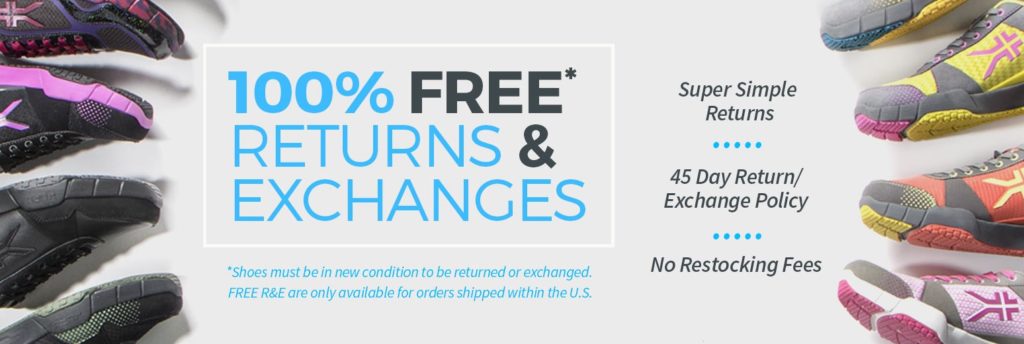
Free returns can become very costly for items that have high shipping costs such as a couch or television. Therefore think about what products are worth offering with free return shipping. Products that are light and small with good gross margins are good candidates as the reverse shipping costs won’t eat up all your profits. Expensive or high-end luxury products are prime examples of products that enjoy a good margin and are excellent candidates for free return shipping.
Nevertheless, try to keep returns to a minimum by helping customers choose the right item in the first place. This can be done by having a detailed product information section, several size charts, FAQs, and useful visualizations.
Besides making it free, make sure that the customer receives hassle-free service during the return process. This can be achieved by giving them clear instructions on the site or including a pre-paid return shipping label inside the original package itself.
6. Offer Free Shipping to First-Time Customers Only
Getting customers to try your products can be the biggest hurdle in growing your ecommerce business. Offering free shipping could be the nudge that customers need to buy from a new online Seller. Such an offer makes sense for a retailer who is looking to broaden its base or acquire new customers.
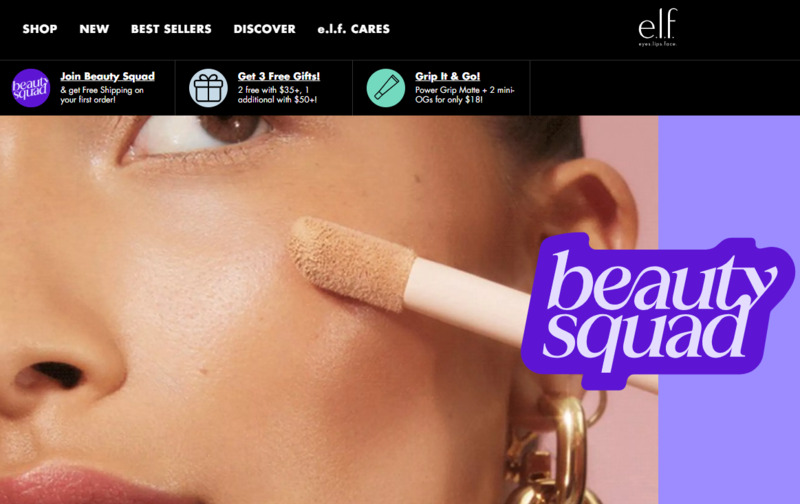
It is a simple but effective shipping strategy. Many successful businesses, such as Postmates or Grubhub, have used it in the past to get the customer on board. Once the customers realize the value of the service, they stay on to become regular paying users.
Whether you’re an existing ecommerce Seller with a new product offering or a brand new online store, free shipping on the first order can get the product out into the hands of new customers. This is especially useful in consumable categories like pet food, coffee and vitamins where customers tend to order the products at routine frequency but are not sure if they are ready to commit to the product or the Seller just yet. It can be considered as an online version of free sampling.
7. Offer Date-Certain Shipping
When free shipping is not an option, showing guaranteed delivery dates helps manage customer’s shipping expectations. Online Sellers should explore offering customers options for different delivery dates with different shipping charges. The slowest one might be offered free, but it still has a guaranteed date of delivery.
Guaranteed dates also help customers to make decisions faster because it takes out the mental math of “delivers in 5-7 business days”. Amazon and Walmart have used this shipping strategy successfully for a long time. Amazon has increased the accuracy of delivery date moving from a range to a specific date for this very reason.
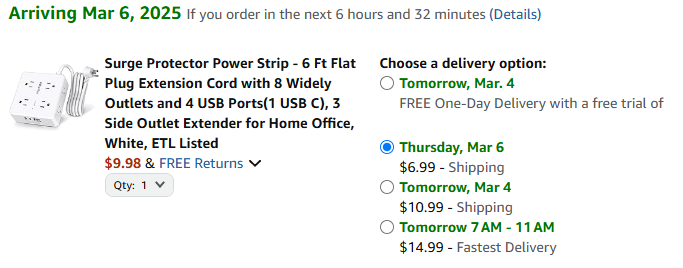
A Seller should keep a couple of things in mind while implementing date-certain shipping options. They should create a sense of urgency by showing how long the delivery date promises will be valid before they change based on same-day shipping cutoff times (e.g. “If you order in the next…”). Moreover, the tracking should be made available to the customer in great detail to create transparency and further decrease anxiety.
Such options ease the customer’s mind because they can see the trade-off between spending more on shipping compared to the resulting delivery delay. This lets different types of customers choose and complete purchases depending on which tradeoff has a higher priority.
8. Consolidate and Deliver Multiple Orders on Fixed Dates
Explore the possibility of consolidating all your orders and ship them all together on dedicated days to decrease overall logistics costs. This strategy can be used in conjunction with zone-skipping and applies to 1) fulfilling single-customer orders, 2) fulfilling multiple orders for the same customer, and 3) transporting goods between your warehouses and B2B customers such as retail outlets.
For the first one, examples would include crowdfunding campaigns and preorders, where the availability of a product such as a Kickstarted Boardgame project or new release music becomes available all at once in bulk. By presetting customer expectations about shipping and estimated delivery dates, you can offer economical shipping options by processing orders in bulk (just one time), thereby reducing labor and related fulfillment costs as well as longer transit options such as hybrid shipping services.
For the second one, this works well if you have repeat business coming from the same customers (DTC or B2B) on a recurring schedule. By grouping orders from a customer throughout the week, for example, and shipping all orders together on a pre-determined day of the week, (e.g. “Amazon Day”), shipping and logistics cost are minimal compared to shipping them all in real-time.
For the last one, this works well if you have a brick-and-mortar presence. The main idea is delaying inventory replenishment until you have a full truckload of goods per shipment (going out or coming in). Shipping efficiently (a full truck) reduces the logistics cost of each item carried. Having a good demand forecast is key in minimizing stockouts and estimating optimal shipment schedules. A set shipment schedule provides carriers certainty of future business and can help in your negotiations as well.
Summary
Free shipping isn’t just about meeting customer expectations, it’s a tool that can be leveraged to grow your business. By structuring your promotions thoughtfully, whether through minimum order thresholds, loyalty programs, or limited-time offers, you can encourage higher or more frequent spending while keeping costs under control. The best marketing strategies don’t just attract customers; they create long-term relationships. With the right approach, free shipping can not only increase immediate sales but also build a loyal customer base that returns again and again, making it a cornerstone of your long-term success. The secret lies in understanding your margins, leveraging data-driven insights, and continuously optimizing your approach.
Download The Ultimate Guide to Profitable Free Shipping
Frequently Asked Questions
Is free shipping a marketing strategy?
Free shipping is a marketing strategy by online stores that allow shoppers and customers not to have to pay an additional fee when placing orders for particular items. From the online shopper’s perspective, getting no additional cost to an item purchased from a website makes shopping much easier.
How to advertise free delivery?
Consider offering free shopping when purchasing 3 or more items. Another example of promoting this method is: let’s say a customer reaches the checkout page, you can recommend other products with a message saying, “add one more product to your cart to be eligible for free delivery.”
Does Free Shipping Increase Sales?
Free shipping significantly impacts sales by reducing cart abandonment rates and increasing purchase conversions. Studies indicate that customers prefer free shipping over paid options, which can lead to higher sales volumes.
What are free shipping promotions?
Free shipping is an increasingly popular option for online shopping, where customers do not have to pay an additional shipping charge. Free shipping is attractive to customers who appreciate simple pricing structures, making it a potential competitive advantage for online businesses.
How do you determine the minimum value for free shipping?
To calculate your free shipping threshold, you need to know your average order value (AOV) and your average shipping cost (ASC). A simple formula is to multiply your AOV by 1.5 and add your ASC.
Why free shipping is not free?
For cheaper items, you simply can’t absorb the cost of shipping. If your product costs $6 and the cost of shipping is $8, you are going to lose money by offering free shipping. Your margins may differ across products, depending on the cost of manufacturing, as well as the size and weight of different items.

Up to 64% Lower Returns Processing Cost
